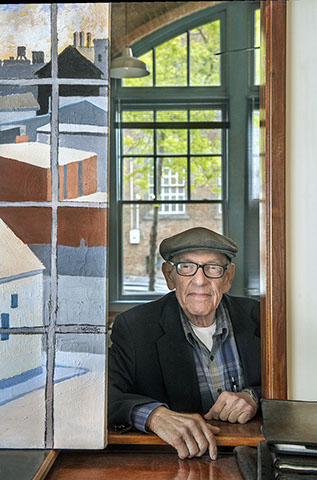William A. Gould, FAICP
2015 ROBERT P. BERGMAN PRIZE
If you’re a young urban planner hired to identify the proper site for the Cleveland Orchestra’s summer home, and you have to sit in a rural field under the stars to listen to the night ambient sounds, it’s not bad to have the venerable conductor George Szell sitting next to you.
That’s where Bill Gould found himself in 1963, only two years after founding William Gould & Associates in Cleveland, when the Musical Arts Association retained him to search for the site that culminated in the creation of Blossom Music Center.
 “I was in my early 30s, not quite knowing what I was getting into,” Bill says.
“I was in my early 30s, not quite knowing what I was getting into,” Bill says.
“But there was no one else in our field who had dealt with land use, planning and development as it related to architecture, since urban planning was a relatively new field at that time.”
Bill grew up in Lakewood and Shaker Heights, and often took drawing classes at the then Cleveland School of Art, but he enrolled in the pre-med track at the University of Michigan in Ann Arbor. That was until the freshman cut through the School of Architecture to get to his dorm one day, but was stopped in his tracks by the detailed architectural drawings and watercolor renderings on the walls. He transferred to the school the following year and earned his Bachelor of Architecture in 1952.
After a short stint in the military, he spent the summer of 1956 studying at L’Ecole de Beaux-Arts, Fontainebleau, France, and then enrolled in the Cranbrook Academy, which follows the precepts of Eero Saarinen and the Finnish School of Urban Planning. There, he earned his Masters of Architecture & Urban Planning.
He returned to Cleveland, walked into City Hall, and asked the Planning Director what was going on with the city and were there any planning jobs? The director gave the plucky young architect an entry-level map-coloring position. A year later, he was employed in the offices of architect J. Byers Hays (Cleveland Arts Prize, 1962), who was overseeing the design of the 1958 Cleveland Museum of Art expansion.
During that time, he began teaching at Kent State University and Case Institute of Technology, where he met the love of his life and unofficial business partner for the next 50 years, Harriet. For their honeymoon, the newlyweds spent a couple months inspecting fountain squares throughout Europe.
In 1961, Bill launched William Gould & Associates, and went on to compile an expansive curriculum vitae of landmark urban planning and design projects, including planner for a 2,200-car underground parking garage topped by a landscaped town square known as Cascade Plaza in Akron; planner on Cleveland’s Downtown Master Plan in 1975; planner/architect for Greenwood Village, Ohio’s first planned unit development in Sagamore Hills Township; and planner/architect for RTA rapid stops at Shaker Square and West 25th Street.
Retained by the Cleveland Landmarks Commission in 1977 to prepare one of the first historic district studies in the US, Gould was instrumental in preserving and restoring the Warehouse District. He founded the ArtSpace movement in Cleveland in 1977, and in 1998, he completed the study necessary to help Cleveland enact the city’s first Live/Work overlay Zoning District Ordinance in 2001 to permit shared occupancy with industrial and warehouse activities with special incentives for artists.
He and Harriet moved into the top floor of the 1400 Building, where he had his business offices and also ample room to create his renowned watercolor paintings, which continue to be shown and sold. Today, they live in one of the artist spaces in the Tower Press Building, which he had helped plan under Mayor Mike White.
Bill is a member of City Artists at Work, a Board member of the Historic Warehouse District, a past board member of the Cleveland Heights Planning Commission, and served as President of the Cleveland Chapter of the American Institute of Architects from 1990-1992. In 2009, he was granted a prestigious Fellowship of the American Institute of Certified Planners title.
“Bill has had a very distinguished career as an outstanding architect, urban designer and artist who has contributed greatly to the aesthetic feeling of the city of Cleveland,” says Norman Krumholz,(Cleveland Arts Prize, 2007) a professor at the Levin College of Urban Affairs and former Planning Director for the City of Cleveland.
Cleveland Arts Prize
P.O. Box 21126 • Cleveland, OH 44121 • 440-523-9889 • info@clevelandartsprize.org